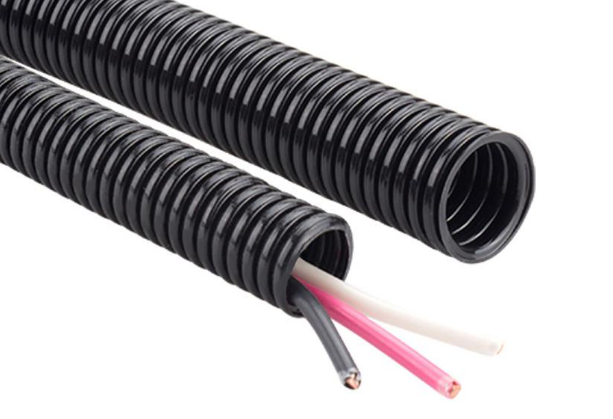Jul. 25, 2023
Flexible conduits are essential components in electrical and mechanical installations, providing protection for wires and cables while allowing flexibility and ease of installation. Two main types of flexible conduits commonly used are metallic flexible conduit and non-metallic flexible conduit. Each type has its unique characteristics, advantages, and applications. In this article, we will explore the key differences between metallic and non-metallic flexible conduits.
1. Material Composition:
- Metallic Flexible Conduit:
Metallic flexible conduits are typically made from materials such as galvanized steel, stainless steel, aluminum, or copper. The metal construction provides excellent protection against mechanical damage, impact, and crushing, making them suitable for applications where the conduit may be exposed to harsh environments or heavy-duty conditions.
- Non-metallic Flexible Conduit:
Non-metallic flexible conduits, also known as plastic or PVC conduits, are made from various thermoplastic materials, including PVC (Polyvinyl chloride), PE (Polyethylene), and nylon. These conduits offer resistance to corrosion, UV rays, and chemical exposure, making them suitable for both indoor and outdoor installations.
2. Flexibility and Bend Radius:
- Metallic Flexible Conduit:
Metallic conduits are generally less flexible than non-metallic conduits due to their rigid metal construction. However, they still offer some flexibility, allowing bending and routing around obstacles. The bend radius of metallic conduits is usually larger than non-metallic conduits, limiting their use in tight or complex installations.
- Non-metallic Flexible Conduit:
Non-metallic conduits are highly flexible and easily bendable, making them ideal for installations requiring tight bends or complex routing. They have a smaller bend radius compared to metallic conduits, which allows for greater flexibility in confined spaces.
3. Electrical Conductivity:
- Metallic Flexible Conduit:
The metal composition of metallic conduits provides electrical conductivity, which can be advantageous in certain applications where grounding or electromagnetic interference (EMI) shielding is required. Metallic conduits can serve as effective EMI shields, protecting sensitive electronic equipment from external electromagnetic interference.
- Non-metallic Flexible Conduit:
Non-metallic conduits are non-conductive, meaning they do not provide electrical grounding or shielding capabilities. However, their non-conductive properties can be beneficial in environments where electrical isolation is necessary.

Non-Metallic Corrugated Conduit - PAFSV0 Series(UL 1696)
4. Corrosion Resistance:
- Metallic Flexible Conduit:
Metallic conduits made from materials such as galvanized steel or stainless steel offer excellent corrosion resistance, making them suitable for outdoor and marine applications where exposure to moisture and corrosive elements is a concern.
- Non-metallic Flexible Conduit:
Non-metallic conduits are inherently resistant to corrosion, making them ideal for applications in corrosive environments or where exposure to chemicals is likely.
5. Temperature and Fire Resistance:
- Metallic Flexible Conduit:
Metallic conduits generally have higher temperature and fire resistance compared to non-metallic conduits. They can withstand higher temperatures and are less likely to catch fire or contribute to the spread of flames in case of a fire incident.
- Non-metallic Flexible Conduit:
Non-metallic conduits have lower temperature resistance compared to metallic conduits. While they are suitable for most general applications, they may not be ideal for installations where extreme heat or fire resistance is required.
6. Weight:
- Metallic Flexible Conduit:
Metallic conduits are typically heavier than non-metallic conduits due to their metal construction. The added weight may be a consideration when planning for overhead or suspended installations.
- Non-metallic Flexible Conduit:
Non-metallic conduits are lightweight, making them easier to handle and install, especially in situations where weight is a concern.
7. Installation and Fittings:
- Metallic Flexible Conduit:
Metallic conduits require specialized tools and fittings for cutting, bending, and fastening due to their rigid nature. Installation may take more effort and time compared to non-metallic conduits.
- Non-metallic Flexible Conduit:
Non-metallic conduits are easy to cut, bend, and install without the need for specialized tools. They often use simple snap-on fittings, reducing installation time and effort.
Applications:
- Metallic Flexible Conduit:
Metallic conduits are commonly used in industrial settings, commercial buildings, outdoor installations, and areas where mechanical protection and durability are essential. They are ideal for heavy-duty applications, machine wiring, and locations with high risk of physical damage.
- Non-metallic Flexible Conduit:
Non-metallic conduits are widely used in residential buildings, light commercial applications, and areas where flexibility, corrosion resistance, and ease of installation are priorities. They are suitable for indoor and outdoor installations, including concealed wiring and surface wiring in dry or damp locations.
Conclusion
Both metallic and non-metallic flexible conduits offer distinct advantages depending on the specific requirements of the installation. Consider factors such as environmental conditions, mechanical protection needs, electrical conductivity, and installation ease when choosing the appropriate type of flexible conduit for your project.
If you want to know more information about metallic and non-metallic flexible conduits, please contact us. We will provide professional answers.















